|
|
|
Sort Order |
|
|
|
Items / Page
|
|
|
|
|
|
|
| Srl | Item |
| 1 |
ID:
161543
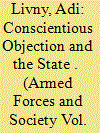

|
|
|
|
|
| Summary/Abstract |
The abundant writing on conscientious objection (CO) had kept one significant actor rather neglected—the state. Relatively unexplored is the question of how democracies shape their policies toward CO. This article wishes to address this gap, focusing in particular on states that maintain conscription, and examining what accounts for their different responses to CO. Based on the Israeli case study, while drawing on comparative insights from The Federal Republic of Germany and Switzerland during the Cold War, I argue that states’ treatment of CO depends primarily on the military’s status and the type of roles assigned to conscription. States in which these roles are mainly functional, and the military does not enjoy, accordingly, a high symbolic status will be more inclined to formally recognize CO than states in which the military fulfills civilian–social roles and enjoys a high symbolic status. Lack of recognition, however, does not necessarily imply harshness; states of the latter sort might nonetheless accommodate CO through unofficial means. Thus, when discussing the policy towards CO a distinction is ought to be made between accommodation and recognition.
|
|
|
|
|
|
|
|
|
|
|
|
|
|
|
|
| 2 |
ID:
152320
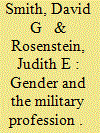

|
|
|
|
|
| Summary/Abstract |
As increasing numbers of women are recruited into the U.S. Navy, retention of women (especially in combat occupational specialties) lags behind men. Data indicate that women and men leave the Navy because of impact on their family. Lack of career persistence for women in nontraditional professions such as science, technology, engineering, and math professions has also been attributed to social psychological factors including self-efficacy, stereotype threat, and bias. We build on this research to examine the military and service academies’ socialization of women into a traditionally male profession through role model influence. Surveys were collected from students at the U.S. Naval Academy (USNA) on their work–family expectations. Results show a gendered difference in career intentions and influences by male and female non-USNA peers, but not from their families or officers. Expected work–family conflict, gender ideology, and family formation intentions were employed to explore relationships between work and family expectations.
|
|
|
|
|
|
|
|
|
|
|
|
|
|
|
|
| 3 |
ID:
173755


|
|
|
|
|
| Summary/Abstract |
Army recruiting, initial entry training, and retention enterprises consume tremendous manpower resources and become disproportionately more expensive and challenging as the size of the Army increases. Fortunately, empirical evidence suggests that the Army could readily improve enlisted continuation rates by changing enlistment contracts from its present form, requiring soldiers to reenlist or opt-in to continue service, to open-ended enlistment contracts that require soldiers to opt-out of service upon fulfilling their service obligations. Changing enlistment contracts to an opt-out paradigm—similar to how officer populations are currently managed—could greatly increase the number of soldiers who continue service past their initial enlistment obligation. Improved continuation rates could save the Army hundreds of millions in recruiting and reenlistment incentives, as well as freeing thousands of Non-Commissioned Officers serving as recruiters, drill sergeants, and retention specialist to support other operational requirements.
|
|
|
|
|
|
|
|
|
|
|
|
|
|
|
|
| 4 |
ID:
160974
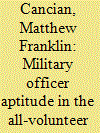

|
|
|
|
|
| Summary/Abstract |
We show a statistically significant and quantitatively meaningful decline in the aptitude of commissioned officers in the marine corp from 1980 to 2014 as measured by their scores on the General Classification Test. This result contrasts with the widely studied increase in the quality of enlisted personnel since 1973 when conscription ended. As a possible cause for this decline, we focus on the fact that, during this period, marine officers had to have a 4-year college degree and there has been an expansion of the pool of young Americans in college. To corroborate this hypothesis, we show that there has been a similar decline in scores on the Armed Forces Qualification Test for responders to the 1979 and 1997 National Longitudinal Surveys of Youth among college graduates but not for the overall set of respondents.
|
|
|
|
|
|
|
|
|
|
|
|
|
|
|
|
| 5 |
ID:
188790


|
|
|
|
|
| Summary/Abstract |
Although humans have voluntarily joined militaries throughout history, research on the motivation to enlist has increased dramatically since the adoption of the All-Volunteer Force in the United States. Moskos categorized the motivations to enlist as institutional (the value alignment of the individual with the military) or occupational (the seeking of monetary rewards for competencies at market rates). This study explores the prevalence of these two traditional motivations in addition to two less commonly studied motivations—group mobilization and revenge-seeking—in an important context: the Kurds of northern Iraq. A survey of 2301 Kurdish soldiers (Peshmerga) during their war against the Islamic State (IS) indicates that institutional motivations are the most prevalent, although all four motivations are present. The importance of group mobilization and revenge-seeking represent important variations from the better-studied Western contexts that complicate our understanding of the motivation to enlist.
|
|
|
|
|
|
|
|
|
|
|
|
|
|
|
|
| 6 |
ID:
160981
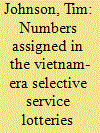

|
|
|
|
|
| Summary/Abstract |
Previous research has reported correlations between the military service records of parents and their children. Those studies, however, have not determined whether a parent’s military service causally influences an offspring’s participation in the armed forces. To investigate the possibility of a causal relationship, we examined whether lottery numbers issued to draft-eligible men during the U.S. Vietnam-era Selective Service Lotteries influenced the military participation of those men’s children. Our study found higher rates of military participation among children born to fathers whose randomly assigned numbers were called for induction. Furthermore, we perform statistical analyses indicating that the influence of lottery numbers on the subsequent generation’s military participation operated through the military service of draft-eligible men as opposed to mechanisms unrelated to service such as “draft dodging.” These findings provide evidence of a causal link between the military service of parents and their children.
|
|
|
|
|
|
|
|
|
|
|
|
|
|
|
|
| 7 |
ID:
183833


|
|
|
|
|
| Summary/Abstract |
Although voluntary recruitment to the military is today the Western norm, we know little about citizens’ beliefs regarding service members’ reasons for joining. This article, reporting and analyzing the results of a nationally representative U.S. survey, rectifies this gap. We find that, despite the reality of market-based recruitment, many Americans continue to subscribe to an idealized image of service members as moved by self-sacrificing patriotism. This belief is most heavily concentrated among conservative Americans. Liberal Americans are more likely to believe that service members join primarily for economic reasons. Those furthest to the left are more inclined to aver that service members join chiefly to escape desperate circumstances. Perhaps most surprising, we discover a disconnect between respondents with military experience and their families: The former are more likely to acknowledge that pay and benefits are a primary motivation for service, whereas their families are more likely to embrace a patriotic service narrative.
|
|
|
|
|
|
|
|
|
|
|
|
|
|
|
|
| 8 |
ID:
169097
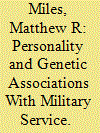

|
|
|
|
|
| Summary/Abstract |
Existing literature connects military service to regional characteristics and family traditions, creating real distinctions between those who serve and those who do not. We engage this discussion by examining military service as a function of personality. In the second portion, we examine military service as predisposed by genetics. Our findings indicate there is a significant heritability component of serving in the military. We find a significant genetic correlation between personality traits associated with progressive political ambition and military service, suggesting that military service represents a different form of political participation to which individuals are genetically predisposed. We discuss the long-term implications of our findings for policy makers and recruiters.
|
|
|
|
|
|
|
|
|
|
|
|
|
|
|
|
| 9 |
ID:
174837


|
|
|
|
|
| Summary/Abstract |
Despite efforts to improve women’s military representation, mid-career female officers attrit at twice the rate of male peers. Research and theory suggest women’s turnover is influenced by family life including marriage and parenthood. But previous research has grouped women together, failing to extrapolate which factors influence retention of women with different family types. Thus, this study explored a single career point (mid-career) at different family intersections (married, unmarried, with, and without children) to elucidate work and family factors associated with female officers’ retention decisions. Using 2011 Air Force survey data (n = 1,309), regression models tested four hypotheses regarding work and family factors associated with different subgroups’ military life satisfaction and career intentions. Findings indicate that after accounting for satisfaction, work factors were insignificant for all subgroups, but family factors (as hypothesized) were significantly associated with married women’s career intentions. Results suggest that policies targeting family support/satisfaction may improve retention.
|
|
|
|
|
|
|
|
|
|
|
|
|
|
|
|
| 10 |
ID:
160973
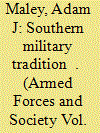

|
|
|
|
|
| Summary/Abstract |
Throughout the history of the United States, the South has had higher levels of military service than other regions of the country. Scholars regularly refer to this phenomenon as a “Southern military tradition.” The reasons behind this overrepresentation are not completely understood. Do Southern sociodemographic characteristics make it a preferred recruiting area or is there something distinctive about the cultural legacy of Southern history that encourages and supports military service? Using a unique data set that includes county-level active duty army enlistments and sociodemographic information, we show that Southern counties have significantly higher enlistment rates than counties in the Northeast and Midwest. These differences disappear when sociodemographic factors, such as fewer college graduates and a prominent presence of Evangelical Christians, are taken into account. These findings suggest that population characteristics may be a stronger driver of current regional disparities in military service than an inherited Southern military tradition.
|
|
|
|
|
|
|
|
|
|
|
|
|
|
|
|
| 11 |
ID:
185254
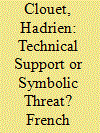

|
|
|
|
|
| Summary/Abstract |
Since the mid-2000s, French military telecommunications have been partially outsourced to private companies. This was justified by an intent for budgetary savings and efficiency. However, an interview survey conducted among military technicians shows that this transfer weighs upon their work and expectations. Outsourcing damages the profession’s appeal, deprives staff of strategic resources, and places their time under the control of private providers. This represents a symbolic cost for the personnel committed to the institution but also grants symbolic benefits to officers who are hostile to the process. Although they were not designed for this purpose, market procedures closely regulate the activity of frontline military technicians.
|
|
|
|
|
|
|
|
|
|
|
|
|
|
|
|
|
|
|
|
|